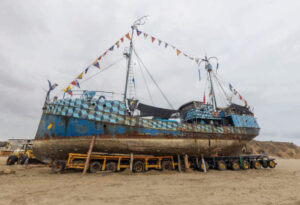![]()
![]()
MISSION ![]()
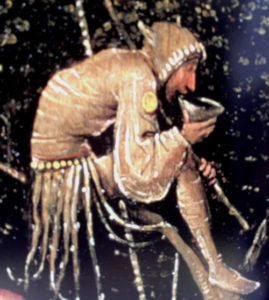
Ship of Fools, Hieronymus Bosch, detail
Azart is a non profit organisation founded to purchase, equip and maintain a seaworthy vessel
for the transport of animals, humans, objects, ideas et aliae to give artists and anyone
a chance to perform their transsubstantional activities
and so to promote a global cultural interchange.
Statutes Azart Foundation 1986
VALUES ![]()
The power of a collective artistic creation.
Folly as one of life's vital elements.
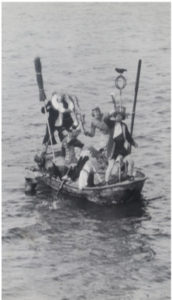
VISION ![]()
An everlasting festive pageant around the world in praise of folly.
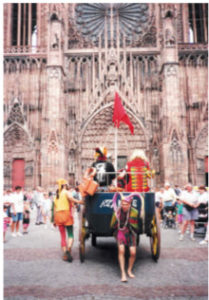
Cathedral de Strasbourg, 1994
THE FOOLS LANDED IN TOWN! ![]()
![]()

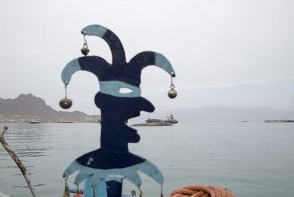
The Fools are in town! Their ramshackle ship a ridiculous and blatant toy upon the waves!
These motley sailors are a boisterous crew that inhabits the public place – to merchandise the living flesh of the spectator! It is the eternal Bateau Ivre that comes to your market places and squares. My God!
These fair folk brew in their floating pots and pans a concoction of greasy soup and black pudding, of absurd dance, roguish song and burlesque theatre. They drink, kiss and fight for the last piece of sausage. They celebrate life and the joy of living. Their show is homage to the culture of Mirth and Laughter, their spectacle the High Mass dedicated to Joyfulness - and a mordant satire of the scurrilous lies of society.
THE CREW ![]()
Stultorum Numerus Infinitum Est (Ecc 01:15)
The Amount of Fools is Endless

Since 2021, the ship's new crew is the theater group Humor & Vida,
Patricia Galarza Zurita, Diana Cancino Cárdenas, Orlando Erazo Oñate y Julio Alvear Caicedo.
Crew 2017
ARTIST RESIDENCE ![]()
Often, there's room on board for volunteers or fellow artists
humoryvida@gmail.com info@corporacionhumoryvida.com
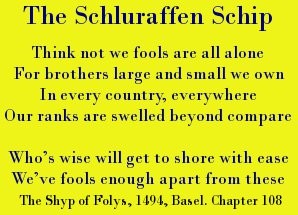
She now is the "Cultural Community Centre Buque Azart",
collaborating with local communities and artists.
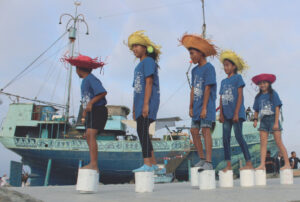
of thirty-three years of the Ship of Fools and of fifteen years of Humor y Vida

A millennial european pelgrimage of playing and gambling
The passion, excitement, eagerness and thrill that are part of any risky venture
THE FIGURE HEAD ![]()
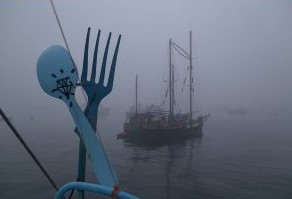
The figure-head is a spoon and fork that signifies: "Here We Come, We Are Hungry".
THE BRIDGE HEAD ![]()
IN SAN MATEO, ECUADOR, THE BLUE SQUARE BECAME A BLUE CIRCLE
BEFORE...

AFTER ...

For thirty-three years the Ship of Fools has been a travelling comic theatre that has performed in over 250 cities in 25 countries.
In every harbour the crew builds ashore a 200m2 "festive fortress" called "The Blue Square"
that includes the ship as stage and backdrop and a seating platform for up to 250 persons.
AZART SQUARE ![]()
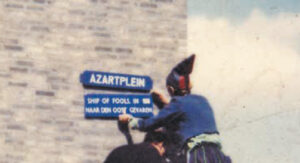
that of a risky passion.
that is still written every day by actors, villagers and audiences on the faraway Azart beach.
More

The Fools present a universal theatre accessible to a public of all cultures and ages,
written in the universal language of comedy,
in a tradition that links the the Roman satires and Saturnalia
with pagan fertility rites, the medieval buffoon, the Commedia dell´Arte, the clown and the Theatre of the Absurd.
It's a grotesque theatre of disguises, distortions and mutilations,
of transgression and transformation, of incongruity and disproportionality,
an optimistic theatre that exalts the salutary laughter of a joyful, malicious and insolent metamorphose.
THE BALANCE ![]()

THE OLD ROUTINE
The entrance-tickets often consist of victuals, drinks, gifts or drawings o the ship.
Otherwise, the spectator is weighed and charged per kilo of body weight in local currency to enter.
This is inspired by mediaeval allegories of the age-old fight between the rich and the poor.
Overweight above 77 kg is gratis, entrance is free above 111 kg.
THE WORLD TOUR ![]()
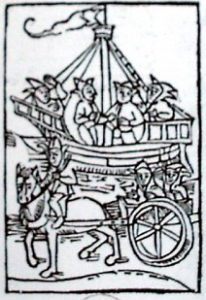 In history, the Ship of Fools always has been a ship on wheels.
In history, the Ship of Fools always has been a ship on wheels.
Azart ended her world travel halfway on a beach in Ecuador
as a giant monument dedicated to folly,
as a comic emblem of the millenial history of European carnival culture
THE FOOL’S LOG BOOK ![]()
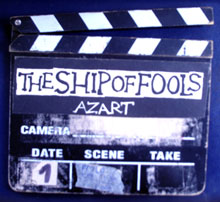
The Fool’s Log Book is a contemporary seaman’s saga on a centenary vessel
the story about the encounters with peoples, nations and the elements.
More
AMBASSADOR ![]()
OF EUROPE'S CULTURAL HERITAGE
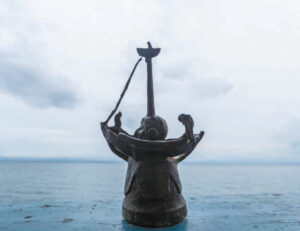
The carnival traditions, a vision that expresses the essence European thinking.
More
CULTURAL AMBASSADOR OF AMSTERDAM ![]()
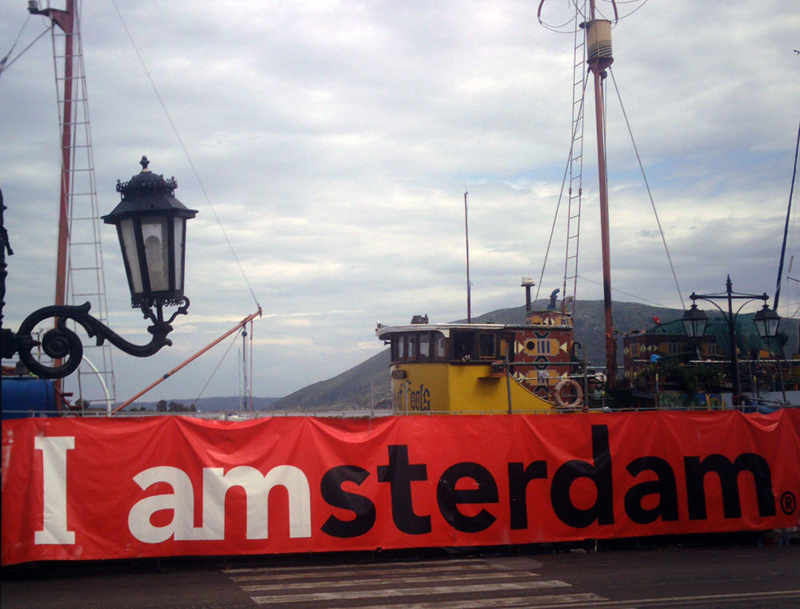
Azart reflects the City of Amsterdam as a cosmopolitan center of meetings,
a unique blend of ancient and modern, a creative fusion of culture and water.
Lord Mayor of Amsterdam
More
MARE LIBERUM ![]()
(Hugo Grotius, 1609)
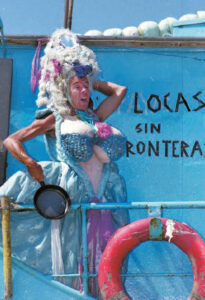
"Fools Without Borders" promote the freedom of the sea,
the right of travel and the freedom of artistic expression
THE HISTORICAL COMIC IMAGERY ![]()
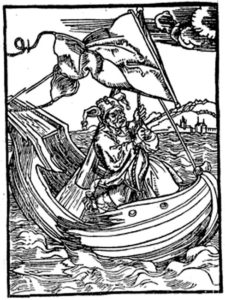
Of Contempt of Misfortune
“Shyp of Folys”, 1494
Chapter 109 Woodcut by Albrecht Dürer
The medieval culture of mockery and laughter is a unique phenomenon that provoked a ‘carnivalisation’ of western conscience and world vision. Her essence is, according to the famous analyse of Michail Bachtin*, the utopian, popular rejoicings of games and laughter, the universal, collective and ambivalent celebration of life and ever rejuvenating time. Its artistic principle is the dethronement of the sacrosanct and the crowning of the forbidden, the motif is the Big Open Mouth, the Gates of Hell that devour everything to give birth again. The fool disposes the licentious wisdom of the feast.
These millennia-old carnivalesque traditions engendered modern literature and played an important role in the reversal of the ‘Holy Order’ of Gods and Kings. It belongs to the essence of the cultural heritage of Europe and of the subsequent cultural patrimony that Europe gave to the world. Among the most exuberant, boisterous and subversive manifestations of this comic universe are the ribald farces, ludicrous processions, donkey feasts, mock-sermons, child Masses, death dances, erotic grammars or jolly funerals that inspired, as an exhortation or admonition, the greatest artists of that time, such as Hieronymus Bosch, Albrecht Dürer, Sebastian Brand and Pieter Breughel and continues to inspire the public imagination and many a modern artist to this day.
* Mikhail Bakhtin, Rabelais and His World, 1965
THE SHYP OF FOLYS ![]()

The Ship of Fools is the exquisite emblem of that comic universe of flamboyant popular laughter, it is the wheeled vehicle of the carnivalesque celebration of the powers of abundance. The Ship of Fools is a timeless image of the world turned upside down, in a spectacular play of identities:
the King is a fool, the Fool a king, the poor are rich and the man - a woman! The Fool holds a mocking mirror in face of society, reflecting – and undermining the established order. The Ship of Fools is a symbol of mankind adrift, of the society that has lost its bearings.
More
THE BLUE BARGE ![]()
Azart assumes proudly The Bleu Barge as her beggar's nickname
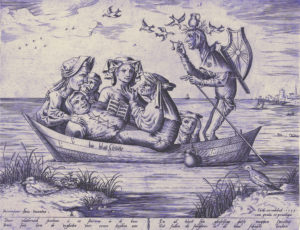
"Die Blau Schuyte" (The Blue Barge). Pieter van der Heyde, 1559. Hieronymus Bosch inventor. Rijksmuseum, Amsterdam.
Because the jester FlatPants is both a musician and a helmsman The birds see him as a fool
And even though his company sings lustily They will be called the singers of the blue barge
FIVE "SHIP OF FOOLS" COMPOSITIONS OF HIERONYMUS BOSCH

Desiderius Erasmus. In Praise of Folly, last line (5011)
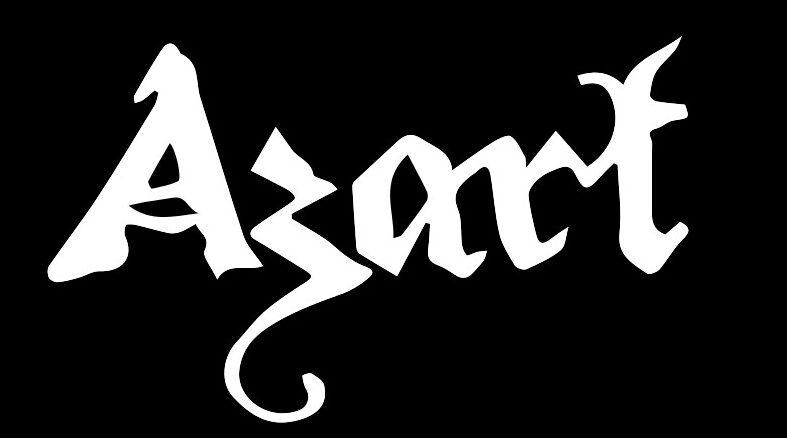
.jpg)

